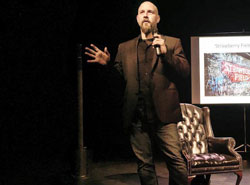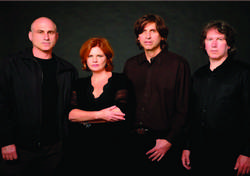Tuesday Night Record Club took a look at “the act you’ve known for all these years,” The Beatles, and covered the album that inspired bands like The Who, The Beach Boys, and so many others to change their sound in a big way. Over 100 people – MU students, faculty, and other community members alike – met in Lauren K. Woods Theatre to discuss the influence of one of The Fab Four’s most iconic albums, Sgt. Pepper’s Lonely Hearts Club Band on Mar. 21.
Beatles fans were welcomed into Woods Theatre to dive into the stories, production, and musicianship behind the album. The discussion was led by the Dean of the School of Humanities and Social Sciences, Kenneth Womack, and professional photographer and Beatles enthusiast from New Orleans, Jason Kruppa. The two began by explaining how the making and release of the single “Strawberry Fields Forever” was a big turning point for the band. The single was supposed to be a part of the album, but ultimately was released in February of 1967, four months before Sgt. Pepper’s was released on June 1, 1967.
Although it was not part of the album, “Strawberry Fields” was a good indication of the new direction The Beatles were headed toward by really taking the time to physically cut tapes of recordings of different takes to make the exact sound the guys were looking for. They discussed how recording technology was not nearly the same as today, and to merge different takes of a song together or to cut small parts of a song out was not easy.
A normal album would have taken about 10 hours to record and master, Sgt. Pepper’s took 700 hours. This statement alone shows us how much thought the guys (mostly John Lennon, Paul McCartney, and George Martin, their producer), put into this composition. Dean Womack made a comment about how the job of rock bands at this time was to make an album really fast and then go on tour for it. The Beatles were so popular and successful, they didn’t have to stick to those industry norms.
Dean Womack described the album as being timeless for all of the “musical colors” it portrays in our head rather than a concept album, which many people tend to label it. The album begins with the title track “Sgt. Pepper’s Lonely Hearts Club Band,” which Dean Womack says is most iconic for it’s Jimi Hendrix-esque “dirty guitar” sound that wasn’t like typical Beatles music.
Also, the term “Billy Sheers” was coined from this song to describe a melodic configuration that creates a sense of resolution, what in music theory is a cadence. This song goes right into the second track “With a Little Help From My Friends” and Kruppa explains how the whole album is recorded so that there are no pauses in between any of the songs, also uncommon for bands to do at this time.
The next song discussed was the third track “Lucy in the Sky with Diamonds,” which is often remembered for the initials “LSD,” but is actually about a painting by John Lennon’s son, Julian when he was 3 years old. Dean Womack described Lennon’s fascination with Alice Through the Looking Glass and a whimsical adventure feel that this track definitely gives the listener.
The next song that was talked about was “Being for the Benefit of Mr.Kite!” which is the seventh track on the album. Lennon stopped into an antique shop and found an old Victorian circus poster and that is what inspired the whole song. This is an example of what Dean Womack describes Lennon’s song writing as ‘using many found objects,’ taking things from everyday life and making them art. This song was a pivotal example of bringing Avant Garde style into the mainstream, Kruppa commented. An audience member said, “This is a song meant for headphones.”
The next song on the album is “Within You Without You,” one of George Harrison’s only contributions to this album as he has been quoted saying “This is the album I learned how to play chess” because Lennon and McCartney did a lot of the song writing. The sitar, an eastern style of instrument is probably the most significant in this song and according to Dean Womack it very much represents the hippie style and progressiveness that the 60’s was going for and really “gives the album another flavor.”
Dean Womack then played the 12th track “Sgt. Pepper’s Lonely Hearts Club Band (Reprise)” without guitar tracks to make the point that the Beatles were actually very great singers. This reprise brings back the “theme” of the album right before the great ending of the album.
The last track is “A Day in the Life,” the track that is known to “change the record and change the band.” Dean Womack describes the message of this song as Lennon’s cry for class consciousness. The song was inspired by two news articles Lennon found about a car crash and about holes in streets. The line “I’d love to turn you on” is very much debated about and Dean Womack describes it as Lennon’s call to awaken people to what is going on in the world and to pay attention to these issues with class.
Next, we go into discussing the middle section of the song written by McCartney that is called “Freak Out” which transitions the song from a slow ballad into a narrative about a working man which adds to the social commentary of the whole song.
Overall, the album proves to be very unique and influential not only at the time of the album’s release, but has had a lasting influence in music up to today. The Beatles put the most creativity and experimentation into this album and it really was a work of art in every way.
The Tuesday Night Record Club Series has been brought to the university through our GRAMMY Museum Affiliation. The club has done record reviews for Nirvana’s Nevermind, Bob Dylan’s Blonde on Blonde, and Blondie’s Paralell Lines. They plan to have their last Tuesday Night Record Club meeting for this school year on Bruce Springsteen’s Nebraska on April 25 at 7:30 p.m. in Wilson Auditorium.
IMAGE COURTESY of Michael Thomas, Associate Dean of the School of Humanities & Social Sciences



